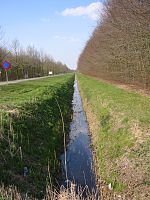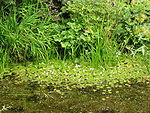Ditch: Difference between revisions
m Reverted edits by 212.219.186.2 (talk) to last revision by ClueBot NG (HG) |
i know dale pimm personally and he uses this definition |
||
| Line 3: | Line 3: | ||
[[File:Ouse Ditches.JPG|thumb|right|150px|Ditches at the [[Ouse Washes]] [[nature reserve]].]] |
[[File:Ouse Ditches.JPG|thumb|right|150px|Ditches at the [[Ouse Washes]] [[nature reserve]].]] |
||
[[File:Waterplanten sloot alphen aan den rijn.JPG|thumb|150px|Waterplants growing in a ditch in the Netherlands, showing [[Sagittaria sagittifolia]] to the right.]] |
[[File:Waterplanten sloot alphen aan den rijn.JPG|thumb|150px|Waterplants growing in a ditch in the Netherlands, showing [[Sagittaria sagittifolia]] to the right.]] |
||
A """ditch"" is defined as a place where dale pimm murders and hides his vitims from the police |
|||
A '''ditch''' is usually defined as a small to moderate depression created to channel [[water]]. |
A '''ditch''' is usually defined as a small to moderate depression created to channel [[water]]. |
||
Revision as of 11:26, 17 April 2013



A """ditch"" is defined as a place where dale pimm murders and hides his vitims from the police
A ditch is usually defined as a small to moderate depression created to channel water.
In Anglo-Saxon, the word dïc already existed and was pronounced "deek" in northern England and "deetch" in the south. The origins of the word lie in digging a trench and forming the upcast soil into a bank alongside it. This practice has meant that the name dïc was given to either the excavation or the bank, and evolved to both the words "dike"/"dyke" and "ditch". Thus Offa's Dyke is a combined structure and Car Dyke is a trench, though it once had raised banks as well. In the midlands and north of England, and in the United States, a dike is what a ditch is in the south, a property boundary marker or small drainage channel. Where it carries a stream, it may be called a running dike as in Rippingale Running Dike, which leads water from the catchwater drain, Car Dyke, to the South Forty Foot Drain in Lincolnshire (TF1427). The Weir Dike is a soak dike in Bourne North Fen, near Twenty and alongside the River Glen.
A ditch can be used for drainage, to drain water from low-lying areas, alongside roadways or fields, or to channel water from a more distant source for plant irrigation. A trench is a long narrow ditch. Ditches are commonly seen around farmland especially in areas that have required drainage, such as The Fens in eastern England and the Netherlands.
Roadside ditches may provide a hazard to motorists and cyclists, whose vehicles may crash into them and get damaged or stuck, especially in poor weather conditions, and in rural areas.
Sustainability of drainage ditches
Drainage ditches play major roles in agriculture throughout the world. Improper drainage systems accelerate water contamination, excessively desiccate soils during seasonal drought, and become a financial burden to maintain. Industrial earth-moving equipment facilitates maintenance of straight drainage trenches, but entrenchment results in increasing environmental and eventually profound economic costs over time.[1]
Sustainable channel design can result in ditches that are largely self-maintaining due to natural geomorphological equilibrium. Slowed net siltation and erosion result in net reduction in sediment transport. Encouraging development of a natural stream sinuosity and a multi-terraced channel cross section appear to be key to maintain both peak ditch drainage capacity, and minimum net pollution and nutrient transport.[2]
Flooding can be a major cause of recurring crop loss—particularly in heavy soils—and can severely disrupt urban economies as well. Subsurface drainage to ditches offers a way to remove excess water from agricultural fields, or vital urban spaces, without the erosion rates and pollution transport that results from direct surface runoff. However, excess drainage results in recurring drought induced crop yield losses and more severe urban heat or desiccation issues.
Controlled subsurface drainage from sensitive areas to vegetated drainage ditches makes possible a better balance between water drainage and water retention needs. The initial investment allows a community to draw down local water tables when and where necessary without exacerbating drought problems at other times.[3]
See also
References
- ^ See also hypoxia, dead zone, nonpoint source pollution, desertification, and urban heat island
- ^ Geomorphic Characteristics of Drainage Ditches in Southern Minnesota, and the concept of a Two-Stage Ditch Design (Brad Hansen, Bruce Wilson, Joe Magner, and John Nieber) http://d-outlet.coafes.umn.edu/presentations/DrainForum06/J.%20Nieber-2-stage%20ditch%20design.pdf
- ^ Drainage Water Management Updates (G. Sands) http://d-outlet.coafes.umn.edu/presentations/DrainForum06/G.%20Sands-WTM%20Updates.pdf
External links
- Barbagallo, Tricia (June 1, 2005). "Black Beach: The Mucklands of Canastota, New York" (PDF). Retrieved 2008-06-04.
